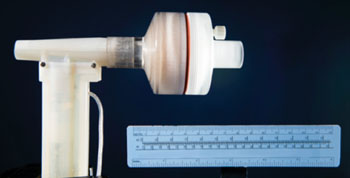Iridium Electrode Generates Therapeutic Nitric Oxide from Thin Air
By HospiMedica International staff writers
Posted on 13 Aug 2015
A lightweight, portable device could provide effective treatment of pulmonary hypertension by generating nitric oxide (NO), according to a new study. Posted on 13 Aug 2015
Researchers at Massachusetts General Hospital (MGH; Boston, MA, USA) developed two generators—an offline and an inline version—that can serve as a simple and economical method of producing pure NO from air. The offline generator can be used to store NO, while the inline generator can be placed directly on the inspiratory line of a mechanical ventilator or anesthesia machine for bedside or portable use. Both use pulsed electrical discharges to produce therapeutic range NO (5 to 80 ppm) at gas flow rates of 0.5–5 L/min, but also other gas mixtures containing up to 90% O2 and 10% N2.

Image: The inline nitric oxide (NO) generator (Photo courtesy of Brian Wilson, MGH Photography Department).
Potentially toxic gases such as nitrogen dioxide (NO2) and ozone (O3), as well as metal fragments from the electrode are removed using a calcium hydroxide scavenger. Further testing revealed that an iridium spark electrode produced the lowest ratio of NO2/NO. In in-vivo tests on lambs with acute pulmonary hypertension showed that breathing the electrically generated NO caused pulmonary vasodilation and reduced pulmonary arterial pressure and vascular resistance index. Both offline and inline systems delivered therapeutic levels of NO for up to 10 days. The study was published in the July 1, 2015, issue of Science Translational Medicine.
“NO therapy is very expensive, and current systems use gas delivered in heavy tanks, making ambulatory treatment impractical. Our new system can economically make NO from the nitrogen and oxygen in the air using only small amounts of electric power,” said lead author Warren Zapol, MD, director of the MGH Anesthesia Center for Critical Care Research. “This device could enable trials of NO to treat patients with chronic lung diseases and certain kinds of heart failure and would make NO therapy available in parts of the world that don’t have the resources that are currently required.”
NO is a ubiquitous signaling molecule that is crucial for the control of blood pressure, blood flow, and other vital bodily functions. NO is also a powerful vasodilator with a short half-life of a few seconds, which works by signaling the smooth muscle surrounding blood vessel endothelium to relax, thus resulting in vasodilation and increasing blood flow. Inhalation of NO has been found to be an effective therapy for treating pulmonary hypertension in adults and pulmonary hypertension of the newborn (PPHN).
Related Links:
Massachusetts General Hospital














